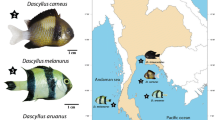Abstract
DNA endoreduplication and related phenomena (such as endomitosis, polyteny, nuclear restitution and somatic polyploidy in general) are widespread over the animal and plant kingdoms, although they occur most frequently among insects and angiosperms1–3. The systematic restriction to certain phyla and species has been interpreted in terms of high genetic control of such events3, whereas the characteristic developmental pattern of various degrees of endopolyploidy has been considered as an expression of their functional role in differentiation and synthesising capacity of the cells2,4,5. Recently,however, any role of endoreduplication in cell differentiation has been questioned because of the existence of species apparently lacking endopolyploidy6. All previous discussions on endoreduplication, endopolyploidy and polyteny have, however, ignored the basic DNA contents of the species studied. We here report a relationship between the basic nuclear DNA content and the occurrence and degree of endopolyploidy. This strongly suggests that DNA endoreduplication can be regarded as an evolutionary alternative to the high nuclear DNA content that has been achieved in other species mainly by ‘saltatory replications’.
Similar content being viewed by others
References
Geitler, L., Endomitose und endomitotische PolyPloidisierung (Springer, Vienna and New York, 1953).
D'Amato, F., Caryologia 17, 41–52 (1964).
Tschermak-Woess, E., in Handb. Allgem. Pathol., 2/1/2 (edit. by Altmann, H.-W.), 569–625 (Springer, Berlin, Heidelberg, New York, 1971).
Nagl, W., Chromosomes Today, 3, 17–23 (1972).
Nagl, W., A. Rev. Pl. Physiol., 27, 39–69 (1976).
Evans, L. S., and Van't Hof, J., Am. J. Bot., 62, 1060–1064 (1975).
Britten, R. J., and Davidson, E. H., Q. Rev. Biol., 46, 111–138 (1971).
Nagl, W., Zellkern und Zellzyklen (Ulmer, Stuttgart, 1976).
Nagl, W., Prog. Bot., 37, 186–210 (1975).
Lima-de-Faria, A., Cold Spring Harb. Symp. quant. Biol., 38, 559–571 (1974).
Britten, R. J., and Kohne, D. E., Science, 161, 529–540 (1968).
Flavell, R. B., Bennett, M. D., Smith, J. B., and Smith, D. B., Biochem. Genet., 12, 257–279 (1974).
Gottschalk, W., Die Bedeutung der Polyploidie für die Evolution der Pflanzen (G. Fischer, Stuttgart, 1976).
Lewis, K. R., The Nucleus, 10, 99–110 (1967).
Murray, B. G., and Williams, C. A., Nature, 243, 87–88 (1973).
DeMaggio, A. E., and Lambrukos, J., Biochem. Genet., 12, 429–440 (1974).
Guern, M., Bourdu, R., and Roux, M., Photosynthetica, 9, 40–51 (1975).
Sparrow, A. H., and Nauman, A. F., Brookhaven Symp. Biol., 25, 367–389 (1973).
Ehrendorfer, F., Taxon, 19, 185–195 (1970).
Van't Hof, J., Expl Cell. Res., 39, 48–58 (1965).
Bennett, M. D., Proc. R. Soc., B 181, 109–135 (1972).
Rees, H., and Jones, R. N., Int. Rev. Cytol., 32, 53–92 (1972).
Sparrow, A. H., Proce, H. J., and Underbrink, A. G., Brookhaven Symp. Biol., 23, 451–494 (1972).
Bachmann, K., Goin, O. B., and Goin, C. J., Brookhaven Symp. Biol., 23, 419–450 (1972).
Author information
Authors and Affiliations
Rights and permissions
About this article
Cite this article
NAGL, W. DNA endoreduplication and polyteny understood as evolutionary strategies. Nature 261, 614–615 (1976). https://doi.org/10.1038/261614a0
Received:
Accepted:
Published:
Issue Date:
DOI: https://doi.org/10.1038/261614a0
- Springer Nature Limited
This article is cited by
-
Endoreduplication changes in five in-vitro-grown crops upon treatment with silver nanoparticles
Plant Cell, Tissue and Organ Culture (PCTOC) (2023)
-
Variability of polyteny of giant chromosomes in Drosophila melanogaster salivary glands
Genetica (2023)
-
Ploidy dynamics in aphid host cells harboring bacterial symbionts
Scientific Reports (2022)
-
Cytogenetic characterization of Mimosa pudica L (Fabaceae): heterochromatin distribution, rDNA mapping and genome size
The Nucleus (2022)
-
Evaluation of endopolyploidy patterns in selected Capsicum and Nicotiana species (Solanaceae)
Biologia (2021)





